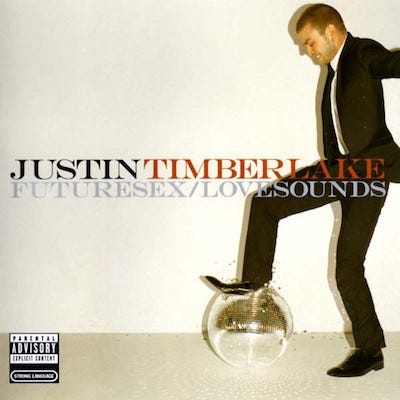- from medium.com
10 years ago, Timberlake and Timbaland bridged dance, pop, and hip-hop with ‘FutureSex/LoveSounds’
Consider this: the tempo and style of the hottest record of the moment ultimately has the potential to shift the entire trajectory of pop music and culture. This is twofold; the obvious reason being that when a formula in popular music is hot, it’s replicated over-and-over again until it has been beaten to death. The other, not-so-evident reason is that nightclub DJs will ultimately build their sets around this hot record, saving it for the peak moment in the evening. And if the hottest record is 115 BPM (beats-per-minute), naturally the DJ will have to find other records that are around the same speed or style to precede and follow it.
On a micro level, said DJ might stay at this tempo for the entire evening — or summer — for that matter. On a macro level, many pop artists will then follow the trend, releasing music at that same speed and style, in order to specifically make sure they are included in nightclub playlists across the planet.
That’s exactly what happened when Justin Timberlake released “SexyBack,” the lead single to his 2006 FutureSex/LoveSounds LP,which turns ten this month and has moved over 20 million copies worldwide to date. Commercial hip-hop was ruling the clubs for almost a decade at that point, with the Jay Z & Beyoncé led brand of 100 BPM club-bangers like “Crazy In Love” and “I Just Wanna Love U (Give It 2 Me)” dominating most mainstream dancefloors. This was interspersed with an influx of slowed down Southern rap hits from artists like T.I. and Yung Joc that clocked around 70–82 BPM.
Justin Timberlake had briefly cracked this market two years prior with hisJustified LP, led by the Neptunes-produced, Pusha T-assisted “Like I Love You” and the Timbaland-backed “Cry Me a River.” Both were huge radio hits, but registered lukewarm as club cuts. Hip-hop and open format DJs weren’t quite ready to fully embrace the former boy band singer, who just two years earlier was engaging in over-produced, soulless plastic pop as a member of *NSYNC.
Both Timberlake and Timberland were in a bit of a creative slump in 2004; While Justin had been keeping busy with other projects, such as acting in films like Shrek and Alpha Dog, he was reportedly feeling uninspired musically. “He didn’t like his voice no more, you know what I’m saying? He didn’t like what he was doing,” Timbaland said in 2007. “I was like, ‘Justin, what’s going on?’
Meanwhile Timbaland was also struggling to find inspiration, as albums on his Interscope-distributed Beat Club imprint from Bubba Sparxx and Magoo were failing to make an impact. Some surmised he was still reeling over the death of frequent collaborator Aaliyah in 2001.
“She was like blood, and I lost blood. Me and her together had this chemistry. I kinda lost half of my creativity to her. It’s hard for me to talk to the fans now. Beyond the music, she was a brilliant person, the [most special] person I ever met,” Tim told MTV in 2008.
Yet once they teamed up with collaborator Nate “Danja” Hills, the trio rediscovered their creative spark by deconstructingJustified’s “Cry Me a River.” They attempted to rebuild it from the ground up, changing bits and pieces of it so that it was not a direct copy. The result was “What Goes Around Comes Around,” the first of ten tracks they completed together forFutureSex/LoveSounds. The eventual double-platinum smash “My Love” would follow, reportedly written by Timberlake in two minutes after he heard the beat. The track had signature Timbaland beat-box drums, but very uncharacteristic electronic trance synths layered on top.
“I heard dance and techno and was always interested in it but didn’t really know where to go. But I went to a club one night and saw that people were losing their mind to these dance tracks,” Danja told Vibe in 2011. “It wasn’t really that I wanted to mimic that sound. I just wanted to have that energy and have people going crazy. So I knew the fusion was putting R&B with trance. As soon as I put the ‘boom boom kat,’ I knew it.”
These untapped electronic sounds were used abundantly on the album’s breakthrough single “SexyBack,” really separating the sonics of the entireFutureSex/LoveSounds LP from everything else. Released as the first single from the project, this record marked a turning point for Timberlake. At a speedy 117 BPM, the record was built on a four-on-the-floor house rhythm. It oozed sexuality; Justin’s distorted, muffled vocals sounded almost post-coital in their delivery, as he made references to S&M, dirty babes, and even dropped a “motherfucker” before Timbaland neighed “Take ’em to the bridge!”It showed a dark maturity that was not present on anything he’d done before, the 50 Shades of Grey of pop records of its time.
This faster tempo was employed on several other tracks on the album, such as the cocktail waitress anthem “LoveStoned” or one of the few non-Timbaland tracks, “Damn Girl,” where will.i.am slyly interpolates Flaming Ember’s “Gotta Get Away” drum breakdown, as freaked by Diamond D on “I’m Outta Here.”
And then — naturally — the formula was endlessly copied.
Observing the tenth anniversary of FutureSex/LoveSounds, Danja summed uphis thoughts on its influence this past week: “We shocked the world and shifted the music business. [We] let open the floodgates for EDM to be accepted in the mainstream music world. We changed the game for good, for at least 8–9 years.”

No comments:
Post a Comment